

Price: Jersey: £185 / $235 / €215 - Bibshorts: £235 / $300 / €274
Weight (M): Jersey: 126g Bibshort: 165g
Sizes: Jersey: S-2XL Shorts: M - 2XL
Colour: Black
Dyneema technology and material entered the cycling arena several years ago though the origins and history of Dyneema stretch back a lot further than that. DSM, the Dutch multinational corporation, is the inventor and manufacturer of Dyneema Polypropylene material and also the title sponsor of Team DSM. Dyneema material has been used in the past by Team DSM, whilst Santini released some 'fall proof' bib shorts using Dyneema back in 2017.
Fast forward a few years and it seems there have been some new developments on the Dyneema front. I recently received a sample of the new Nalini Dyneema bib shorts and jersey to test, marking a new chapter in the Dyneema story and potentially an advancement in Dyneema Technology. The Kit is a partnership between DSM, Nalini and Taiana and Kinetech (an Italian textile company). The bib shorts and jersey feature protective Dyneema Protekt panels on the hips and shoulders in order to protect cyclists in the event of a crash. Nalini now has the exclusive right to the Kinetech Protekt fabric, and this newer Dyneema offering is supposedly lighter, stronger and able to be more aerodynamic than previously.
If you're wondering what exactly Dyneema is I'll outline that before we go further. I'll use the Kinetech description of Dyneema, which it describes as a “Polyethylene fibre with an ultra-high molecular orientation, bringing unique properties. With an ultra-high tensile strength 15 times stronger than steel it combines strength with exception lightness”.
In lay terms that means crash resistant, or more specifically abrasion resistant, cycling kit, which is is obviously quite an attractive idea. Road rash or abrasions are never pleasant for any cyclist and the potential for cycling kit to help minimise them is a compelling idea. Team DSM riders have been using the new Nalini kit in competition at Paris Roubaix and as recently as the Tour de France Femmes.
I also remember riding and racing as a young rider in shorts and skinsuits that had been sewn up by my mom after crashing. It struck me that Dyneema fabric would possibly lend itself very well to a protective kit for children and young riders, as well as providing some more peace of mind for parents.
It was going to be one thing to test ride the bib shorts and jersey and review the performance of the kit itself, but I felt like I had to at least try to come up with some sort of abrasion test for the fabric itself, so to see if it delivered on its billing, read on to find out how I got on.
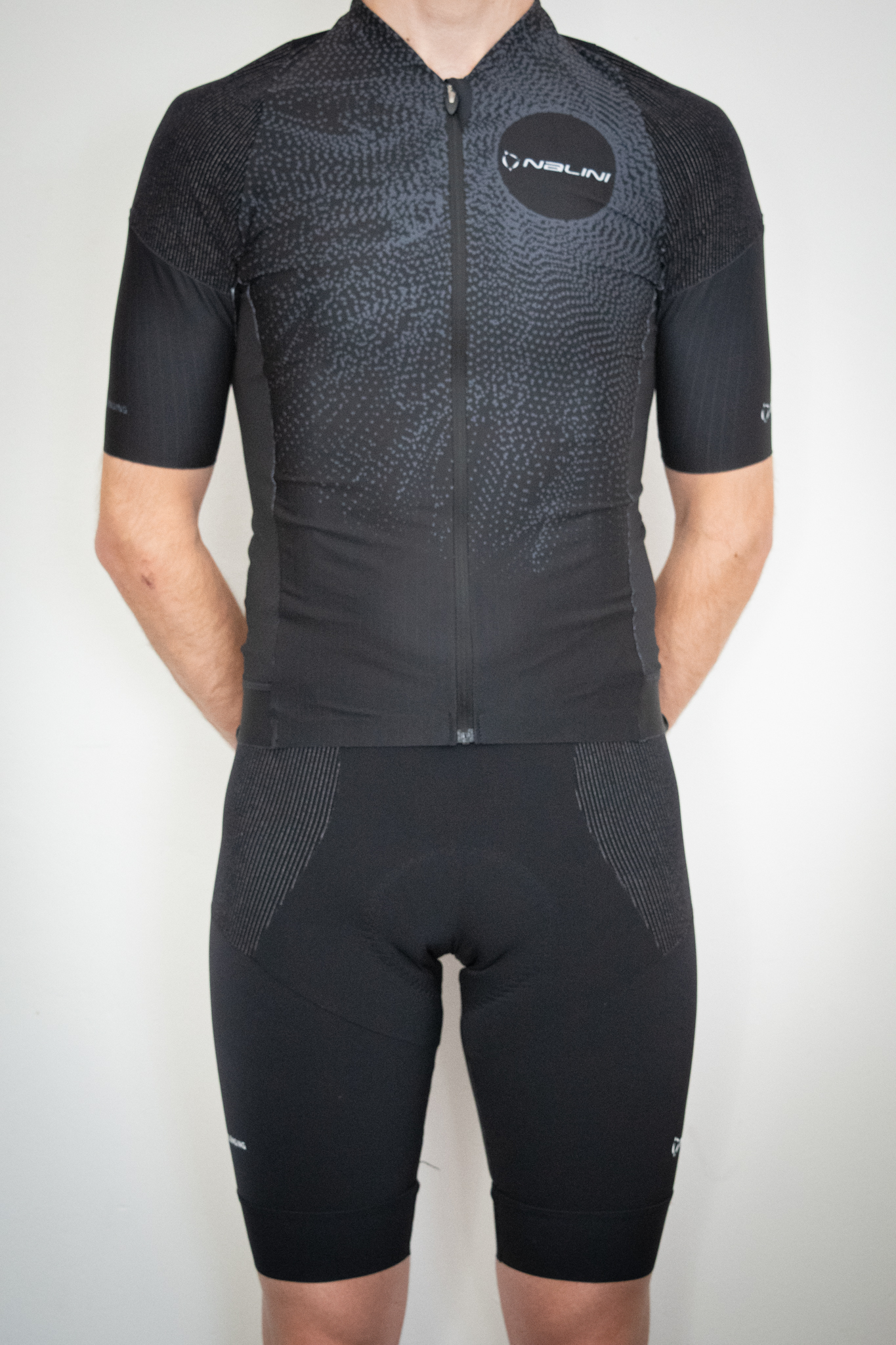
Design and aesthetics
The Dyneema bib shorts come in a single black colour and use different types of Kinetech fabric in their makeup. Dyneema Kinetech Protekt panels feature on each hip. The Protekt material is the fabric which uses Dyneema fibres, elsewhere other types of Kinetech material are used. And the makeup of the shorts overall is Polyamide, Polyethelye and Elastane. I'm guessing the hip area has been deemed the most relevant place for the protective panels to be situated and I'm sure countless cyclists can attest to bruising and grazing their hips in crashes.
The Dyneema Protekt panels themselves are best described as black in colour with very thin and tightly spaced silvery pinstripes and the Protekt fabric is marginally thicker than the rest of the shorts, and has a more textured feel. There is a silicone-free leg gripper which reminds me a little of crepe paper. This isn't meant negatively; the gripper is thick and gripped well. The rear of the bib shorts strap is a thin mesh whilst the straps themselves are wide, stretchy and comfortable. Given the USP of these shorts and jerseys for that matter, I think they could have ended up looking a bit OTT style wise but the styling is subtle, which I really like.
The Dyneema jersey has quite a lot going on and features 10+ different panels and pieces of material. With the main body being polyester/elastane. The Dyneema Protekt panels here are across the shoulders and upper arms (another prime crash damage site) There are then mesh panels on the jersey sides and back, and nice length aero material sleeves which finish above the elbow. There's also a fairly thick gripper on the bottom rear of the jersey which helps keep everything in place which is a nice touch.
Dark all over works well with the Dyneema, and the various different panels and sections also add contrast and break things up. The jersey features a sort of light blue and grey polka dot pattern across the torso. There are three rear pockets (no zipped one) and they hold the kit well without wobble which is important for me. There are three Nalini logos on the chest and rear pocket and arm and DSM 'keep challenging' logo on the other. A YKK zip allows you to adjust the zip one-handed on the bike which, though a small point, is one I always like to test. You will also want to size up if you're investing in the kit yourself at any point. I'm an M in Nalini kit but a small in pretty much everything else. I'm 65kg and about 176cm tall.
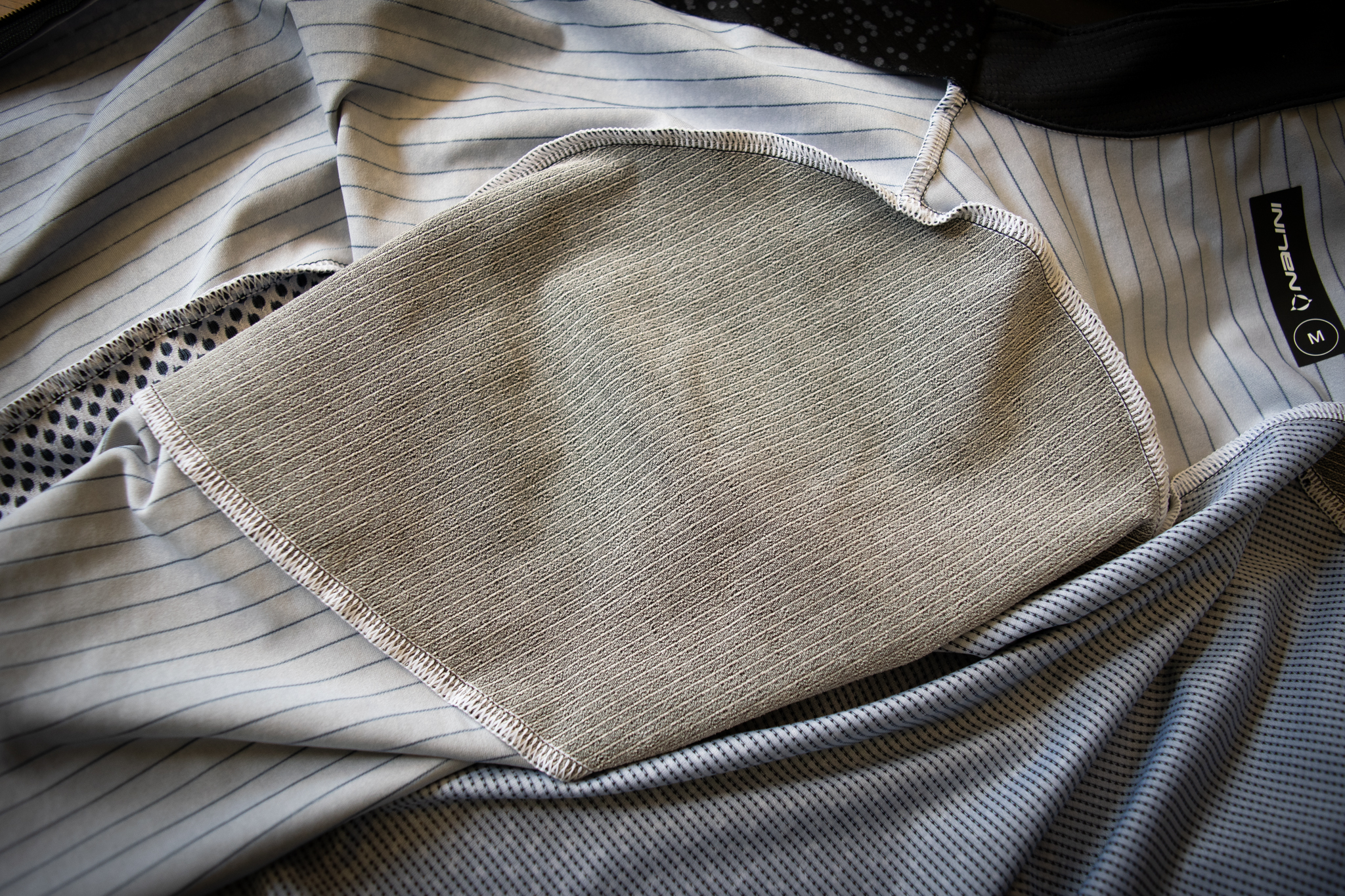
Performance
I've spent a good few hours riding in the Nalini Dyneema bib shorts and jersey now. I've done a range of riding from hour-long easy spins, to hill effort repeats and our local Saturday morning chain gang.
As cycling kit, it performed really well and I couldn't find very much to fault it overall. It caused zero issues in use. Fit and form wise the shorts were spot on for me, the MOA high-density chamois is really plush, I'd probably say at the thicker end of the chamois spectrum overall and I got on with it well without issue on a few different saddles. It's also a bright blue colour, if you're interested. I also learned Nalini manufactures all its chamois pads in-house during my research. The shorts are bang up to date length-wise, not silly long, not too short. and feature a simple Nalini badge on the back, the Nalini logo on the leg and like the jersey a DSM-inspired 'keep challenging' tagline on the other.
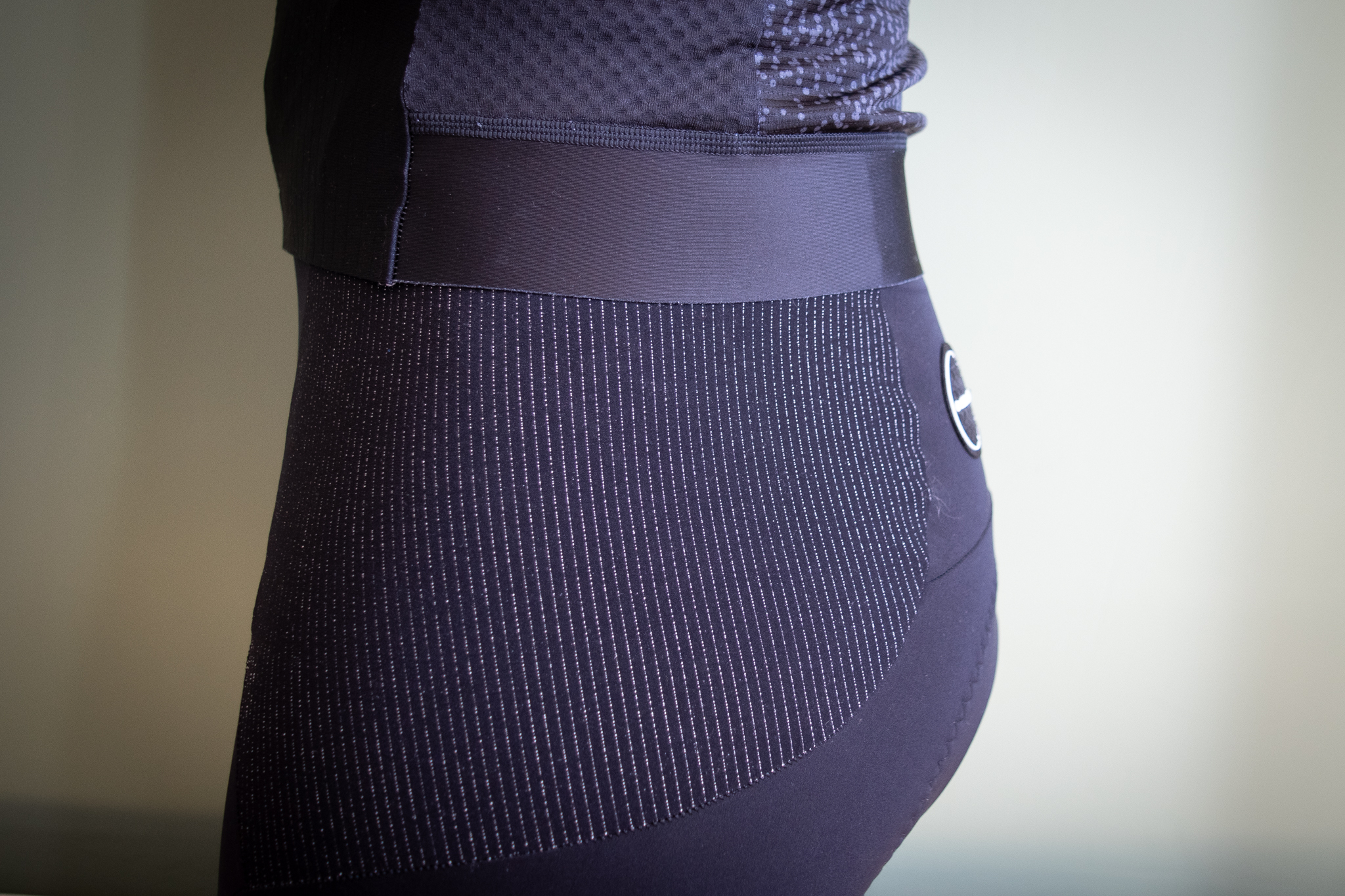
Similarly, I don't have much in the way of criticism for the Dyneema jersey, I got on really well with it and it fitted me excellently. But there are a few more points to discuss than the bib shorts.
As mentioned above, the fit was good. It isn't a hyper-tight race or aero jersey but the cut is performance orientated and there isn't excess material anywhere. There are long-cut, aero sleeves which stay in place very well, which I really liked. I did however find the cut of the neck slightly odd, the V-shaped side sections are doubled over but not stitched down, leading to a slightly loose fit in this spot. I just would have liked the material here to sit a bit flatter and flusher.
I wore the jersey on a muggy day with some light showers and rode fairly hard for about three hours with plenty of climbing. I noticed the thicker Dyneema shoulder sections got a little bit hotter and sweatier than the rest of the jersey on this day. I was wearing a base layer and it wasn't an issue as I was sweating and working hard anyway, but I think on the hottest days or if you like a really light jersey in the summer you may find the Dyneema a little bit warm. I appreciate there is a trade-off to be had here though, perhaps a little more warmth is a fair price for the protection the material offers?
The Dyneema Protekt material on the shoulder was also interesting to keep an eye on, in an exposed area like the shoulders I did wonder if it would be less form-fitting but it behaved exactly like a regular jersey with a close fit, it's just slightly thicker material.
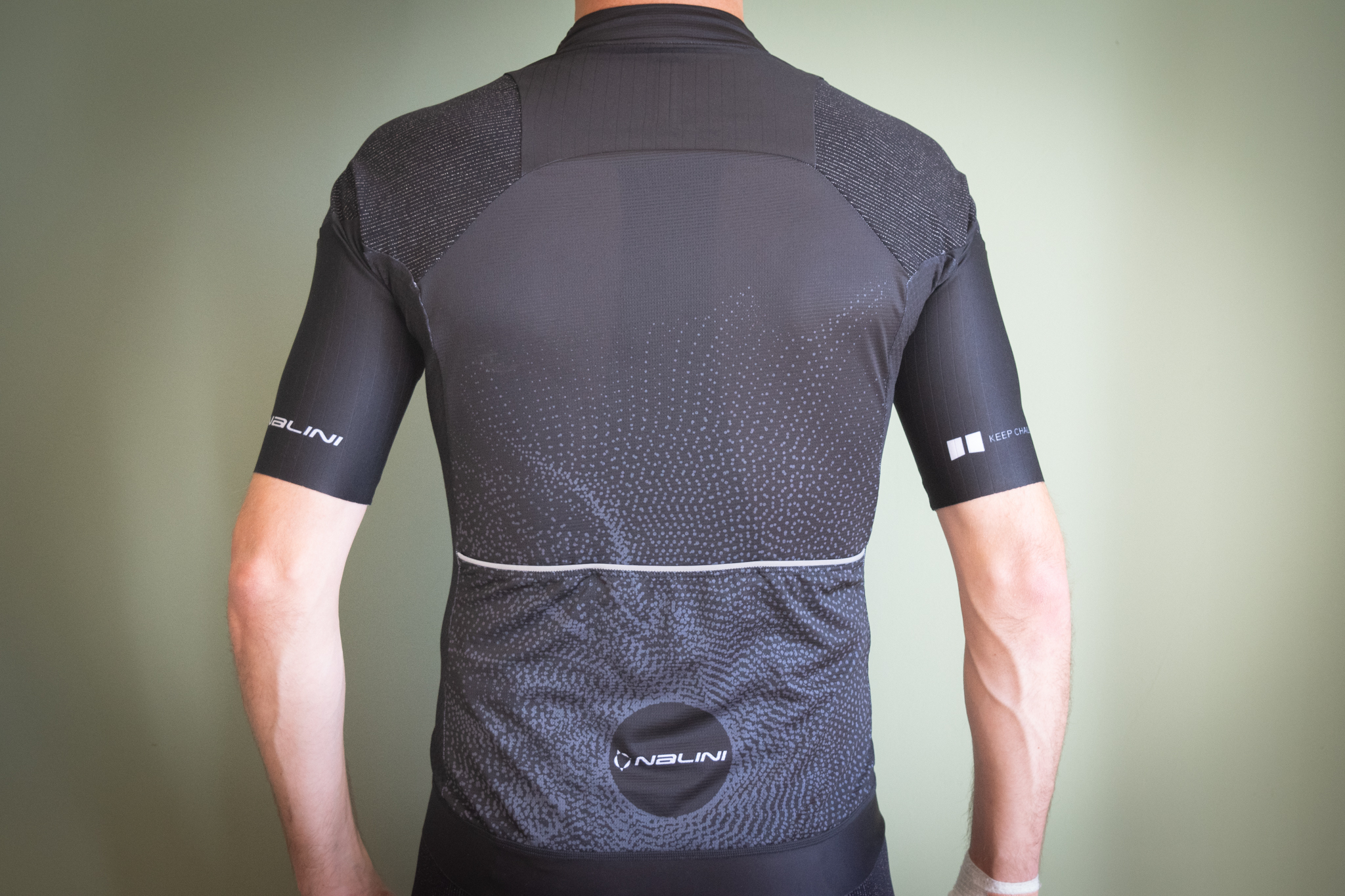
Abrasion resistance
This section of the review will focus specifically on the performance and my test of the Dyneema Kinetech Protekt fabric. Along with my kit I also received a decent-sized sample swatch of the fabric which I planned to test. I certainly wasn't planning to have a crash to test the kit, so spent a bit of time scouting a good location where I could perform something of a controlled abrasive stop.
My test was based on approaching a very long, high brick wall on a quiet road at a planned 15-20mph. My chosen spot meant I could ride on the pavement off the road, and I had a spotter with me to help. I used my Wahoo to gauge speed and tried to replicate the fast and hard initial 'touch down' impact we experience when crashing, which is usually followed by a slide. I acknowledge there are a million ways to crash but I had to start somewhere. I knew I couldn't just crash and frankly didn't want to, so this seemed like a fairly safe, controlled way of doing the test.
I spliced my test 'sleeve' piece of fabric onto a short-sleeved base layer and planned on making contact with my upper arm and elbow against the wall. I repeated the test twice, and around 16mph feels quite fast enough when you are next to a wall and about to stick your elbow into it. I think this type of wall contact could feasibly happen in a real-world riding scenario should a rider lose control or veer dramatically offline. I also think it's pretty similar to when we fall onto and slide along tarmac or asphalt etc.
I really lent into the wall with my upper arm and elbow and made good contact, the first run scuffed up the fabric and loosened a few Dyneema fibres whilst the second did succeed in putting a small hole in the fabric and grazing my elbow and breaking the skin.
It's a difficult thing to gauge and try to analyse but I feel confident that if this had been a regular thin piece of lycra constructed from regular polyester this would have been a far larger hole and a bigger graze for me. Only with the fibres loose and broken up on the test swatch could I get a feeling for the additional strength and structure of the fabric and it's immediately noticeable. Protection would also be increased again if this was a shoulder panel with a base layer being worn under it.
I also, mainly out of curiosity, attacked my test swatch with some scissors and the Dyneema material is noticeably more difficult to cut than regular cloth or lycra. Cutting the fibres themselves at certain angles is challenging and it takes a specific angle of attack to make some progress initially. This isn't a scientific test I know, but it was eye-opening.
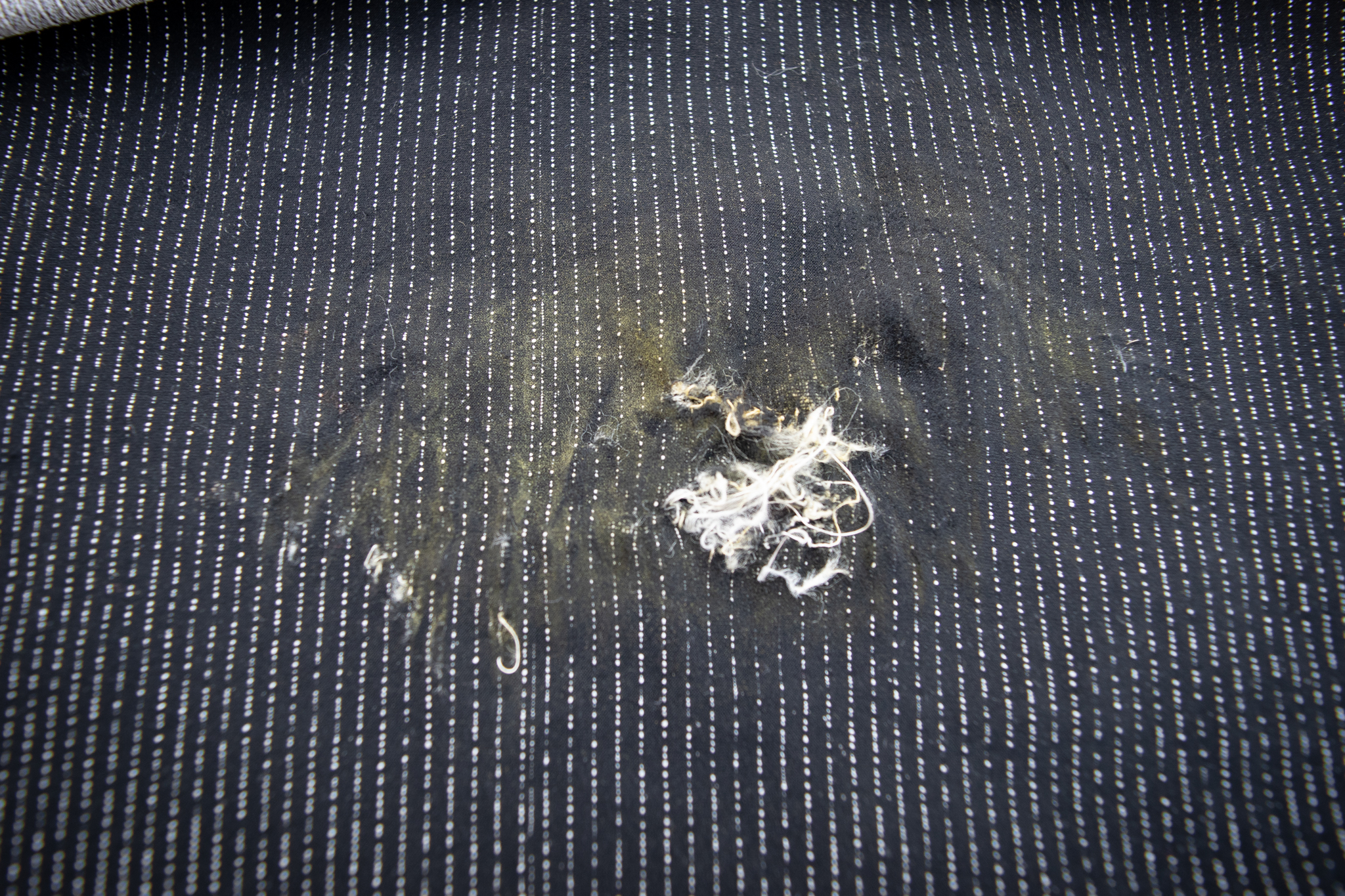
Verdict
It's not just crashing in races or on rides that can injure us and damage kit. Although I'm sure this will be a focus for Team DSM and the team's professional riders. For amateur cyclists and those of us not racing for most of the year, there can be all sorts of accidents that can graze knees, hips and elbows and write off expensive kit. Toppling over at traffic lights or stop signs, falling off on icy driveways (guilty), or perhaps mistiming a hop up a kerb and having an off. I also, unfortunately, took a good chunk out of the knuckle on my right hand during the test, which immediately made me think track mitts or gloves using the material could be useful
I really like the Nalini Dyneema kit itself. It's stylish, quality cycling kit, fitting and performing well. The inclusion of the Dyneema Kinetech Protekt panels isn't a hindrance in anyway way and doesn't restrict movement etc, besides being a little less breathable. I feel confident in saying the material is a lot more resistant than regular lycra and will offer abrasion resistance in the event of a crash. I don't think it's going to completely eliminate damage from crashing. I was able to put a hole in it in one specific place, and my gut and my own test tells me if you come down hard on the bike wearing it you're still going to lose some skin, but I think the scope for it minimising damage from sliding or abrasions is strong. It's all going to depend on the type of crash and there are countless factors at play there.
However, it's naturally hard to factor in a lot of protection to road cycling kit by nature of its design, we can't put on motorbike leathers or padding as it would render the kit too bulky. This is why abrasions and road rash are unfortunately part and parcel of our sport if we crash. I have no doubt Dyneema is a useful technology to use in cycling kit, and the Kinetech Protekt could see the technology gain more traction in the road cycling world. A product that can reduce the extent of certain injuries for riders has to be worth developing, using and investing in.







